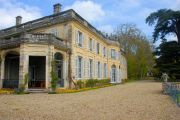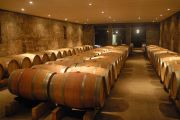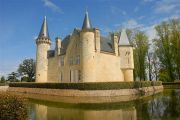 |
 |
In the heart of Médoc |
 |
Every wine lover has one day drunk a bottle of Médoc. This region close from Bordeaux has a long wine making tradition and offers a large choice of oenotouristic activities. If some of them are classic, others are very innovative and allow a new approach of wine.
[ Practical ]
- Getting there
By road
620 km from Paris on autoroutes A6 and A10 till Bordeaux, then on N 215 till the Médoc.
40 km from Bordeaux on N 215
By train
TGV Paris Montparnasse – Bordeaux (3 h 10), then bus 705 from Bordeaux Place des Quinconces to the Médoc.
- Getting around
It’s better to have a car
- Lodging
Le Relais de Margaux
Hôtel Golf du Médoc
Château Cordeillan Bages
Château Maucaillou
Château Cap Léon Veyrin
Château Beauséjour
- Restaurants
Le Relais de Margaux
Hôtel Golf du Médoc
Lavinal
Le Wy
Le Peyrat
Ferme Auberge Guittot-Felleonneau
- Les Médocaines
Bookings through the Office de Tourisme de Bordeaux and the Maison du Tourisme et du Vin de Pauillac
- Château d’Agassac
Ludon-Médoc
0557881547
www.agassac.com
- Winery
Arsac
0556390490
www.winery.fr
- Information
Office de Tourisme de Bordeaux
0556006600
www.bordeaux-tourisme.com
Maison du Tourisme et du Vin de Pauillac
0556590308
www.pauillac-medoc.com
Geographically, the Médoc corresponds to a triangle bounded on the South by a line passing at the level of Bordeaux, on the East by the estuary of the Gironde, and on the West by the sea and some beautiful beaches. The vineyard is located towards the estuary and extends more or less profoundly inland. Besides Médoc wines, it includes several others worldwide famous appellations such as Margaux, Saint Julien or Saint Estèphe.
 Four women at the head of crus bourgeois Four women at the head of crus bourgeois
A fame which does not prevent the owners of estates to innovate in term of oenotourism. First example with the "Médocaines", name chosen by four women at the head of crus bourgeois. Martine Cazeneuve from Château Paloumey, Marie-Laure Lurton, from Château la Tour de Bessan, Armelle Falcy-Cruse, from Château du Taillan, and Florence Lafragette, from Château Loudenne. They decided to unite to make their estates better known and they set up four bilingual French / English thematic workshops that leave a large place to the exchanges with visitors. “We want them to discover our work and our wines on a different way, so they understand how they are elaborated”, they explain. The first one created is the workshop “Vendanges” that, of course, is only takes place at the time of picking, generally in September.

 Château du Taillan © T.Joly Château du Taillan © T.Joly
|
 Make his own wine Make his own wine
Lasting for one day, it is organised in two châteaux. On the morning visitors go to the first one to participate in the grape harvests and the sorting. On this occasion they taste the various grapes cultivated in the area in order to appreciate their differences. Then, after lunch, they go to the second château where they discover the work in the wine storehouse and sample the musts. The second workshop connected to the production is called "Assemblage" and lasts for two hours. Very original, it begins with a tasting of four wines each obtained from one of the varieties of grapes cultivated in Médoc : cabernet sauvignon, cabernet franc, merlot and petit verdot.
So the tourists can learn how to recognize their characteristics. Then, they are submitted to a little practical exercise to see if they remember well the lesson. A blind tasting of a wine where one of the four grapes is dominant and they have to try to identify it. Finally, they are invited to create their own wine, using a pipette to blend the four grapes in the proportions of their choice. " They are always surprised with the results, with the differences of taste induced by blending and they always find them better than wines made from only one grape ", notices Martine Cazeneuve.

 Château du Taillan © T.Joly Château du Taillan © T.Joly
|
 A visit for the families A visit for the families
The last two workshops are a little more classic and deal with the links between wines and gastronomy. One is called "Cuisine", and a chef teaches visitors easy recipes before proposing them a lunch based on harmony between dishes and wines. For the other one, named "Agapes Médocaines", the same chef composes some “bouchées créatrices”, tiny creative dishes made of original associations of flavours, for even more original marriages with the wines of the four châteaux.
In another register, the château Agassac meets the expectations of parents who wish to be able to visit a winery in family without having their children getting bored. It indeed proposes video audio interactive visits guided by Ipod with adult / child and French / English versions. A premiere in France.
Surrounded with ditches filled with water, the half medieval half Renaissance château is one of the most charming of the region and the whole family can walk around together by following a signposted path where each one receives comments adapted to one’s age.

 Château d'Agassac © T.Joly Château d'Agassac © T.Joly
|
 Educational presentation Educational presentation
The children benefit from a playful visit where are mixed in a harmonious way legends, history and description of the castle and the region, the everyday life through the centuries of the Lords and the villagers as well as information on the culture of the vineyard and the elaboration of wines.
A very interesting and educational presentation of the place and the work of the wine growers. The adult version is not as good. If the historic part is once again interesting, on contrary the wine-making activities are presented in a conventional and commercial way. One common point to both versions, is that the visitors can fill a questionnaire and receive a reward if they find all the good answers. A diploma and a box of coloured pencils for the children. A discount on any purchase of wine for the adults.
 A hamlet that comes to life again A hamlet that comes to life again
Owner of the well known Château Lynch-Bages, Jean-Michel Cazes launched out into the protection of the architectural heritage of the village of Bages, where his estate is settled. He bought the houses of the center of the village, restored them and set up three businesses to bring back life in the hamlet. The café " Lavinal " which is also a brasserie and serves a regional home cooking. The " Baba of Andréa ", a traditional bakery. And finally "Bages Bazaar", a trendy shop where are sold souvenirs, wines and art de la table. The whole composes a pleasant place where you can make a break during a day in the region.
Of a totally different style, the Winery stands in Arsac, along the road leading from Bordeaux to the heart of Médoc. Contrary to what suggests its name, no wine is produced there. This vast building with a futuristic look made of glass and steel indeed shelters a wine shop, a bar and a restaurant. Tasting, animations about wine as well as cultural events such as modern art exhibitions and concerts are also organized there.
 One thousand wines One thousand wines
An innovative concept and an architecture some people like while others think it would be better located in a big city. Make your own opinion.
The central element of the complex is the shop which offers one thousand wines ranging from 3 € to 1 000 €, among which 40 % come from Bordeaux and 10 % from foreign countries. Tasting are regularly proposed on various themes such as appellations, vintage, harmony between dishes and wines, vines, … More original, to help people to choose wines they will appreciate, the Winery has an exclusive animation, the " Oenological Sign ". It is a blind tasting of 6 wines of different ages, vines, origin and characters the participants have to judge right away. Then, according to their answers, a computing program determines their consumer's profile (Explorer, aesthete, gourmand,..) and the wines they like. A method presented as scientific but it does not give good results for everybody. It is better to take it only as an entertainment to have a good time with friends or relatives.
October 21, 2009
Thierry Joly 

|
|
 |

|
 |



